Euphorbia white-veined: description and recommendations for care

Euphorbia white-veined (white-veined) is loved by flower growers for its unusual appearance and exceptional unpretentiousness. This houseplant is suitable even for beginners who just got carried away with landscaping their home. However, experienced flower growers often keep this exotic plant in their collection. Let's consider the description of milkweed in more detail, and also get acquainted with the nuances of plant care.
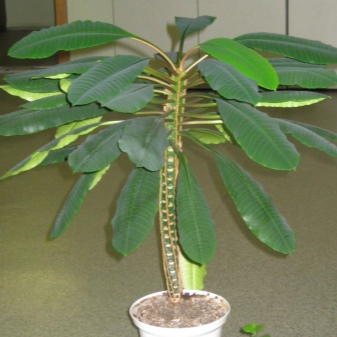
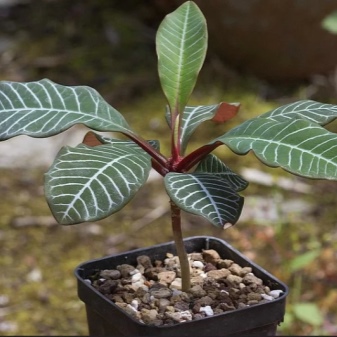
Peculiarities
The homeland of Euphorbia leuconeura is the island of Madagascar, where eternal summer reigns. This culture can also be found in the tropical latitudes of the American and African continents. In their natural habitat, plants grow up to 1.5 m in length, often forming rather dense thickets. Cultivated varieties can also grow to this height, but in most cases they are much smaller in size.
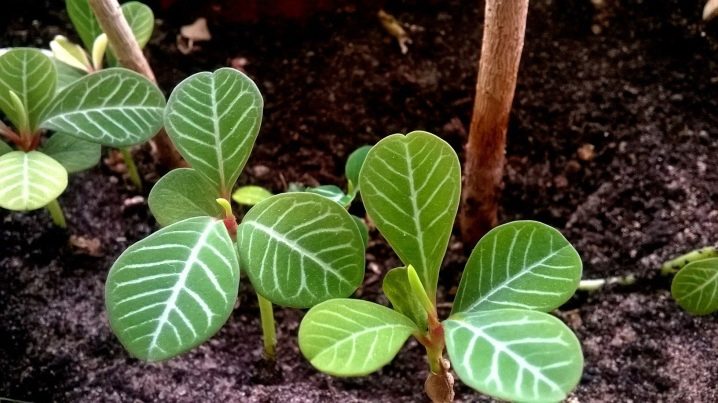
In European countries, white-veined euphorbia began to be grown everywhere in the 20th century. He quickly populated the windows of the inhabitants of the Old World, from where he migrated to Russia and neighboring states. The people call this flower a monkey tree, a banana and even a palm tree. Some confuse it with the comb varieties, but in practice it is quite easy to distinguish the white-veined variety.
If you take a closer look at the leaf plates, you can see well-defined whitish veins.
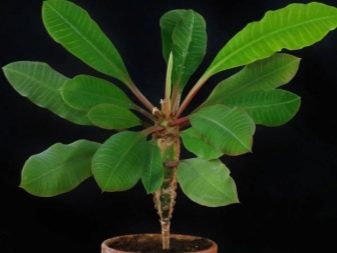
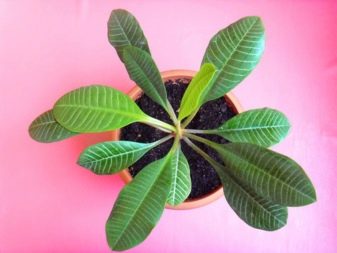
The stem of white-veined milkweed is thinner at the base than at the apex. It is characterized by a rather dense and fleshy structure. On the surface, you can see pronounced scaly ribs, giving the plant some resemblance to cacti. The foliage is placed in the upper part, collected in the form of a rosette. Quite often, as the milkweed grows, the lower leaves gradually fall off, making the plant look like a palm tree.
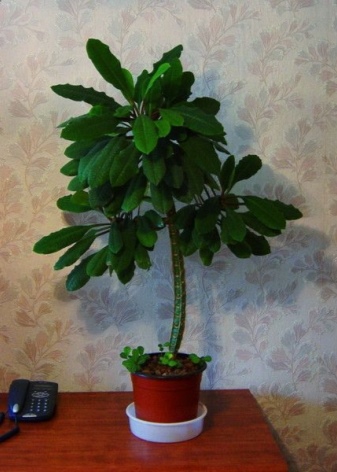
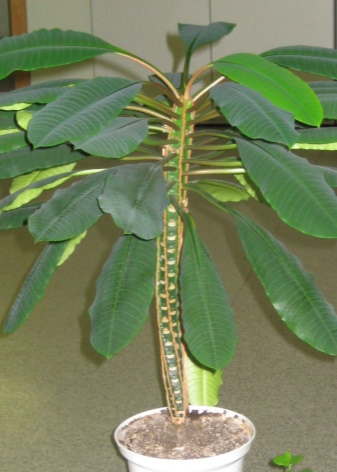
Flowers are located in the axils of the leaf plates, have a rather unsightly appearance, so flowering does not have any decorative function. At the end of ripening, the seed box cracks, while the seeds scatter 4 meters. They often settle and then sprout in nearby pots. To prevent the problem of self-seeding, you need to carefully remove the flowers by rotating them clockwise.
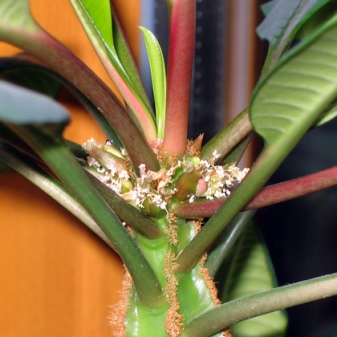
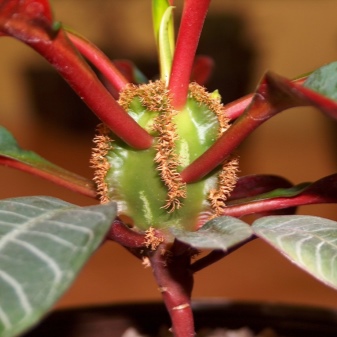
Many people are afraid to keep spurge at home, believing that this is a dangerous plant. Let's understand this issue. Like all other milkweed, white-veined milk secretes a rather poisonous milky juice, which, when it gets on the skin, can cause irritation and burns. Even rare cases of death have been recorded.
Therefore, absolutely all work on the care of this indoor plant must be performed with rubber gloves.
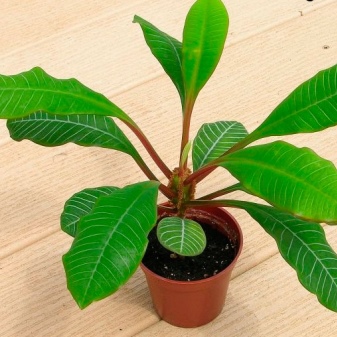
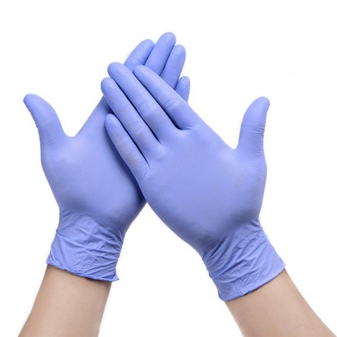
Other precautions are worth taking. Pets, as well as small children, should not be allowed to the flower. Plants should only be placed in stable heavy containers. It is undesirable to place the flower in the kitchen, dining room and other places near food, medicine and drinking water.
However, it should be noted that even dangerous representatives of the flora can be very useful for people. Euphorbia is no exception. The leaves of the flower are widely used in folk medicine as the main component of drugs against severe edema, paralysis, as well as pathologies of the gastrointestinal tract. The effectiveness of milkweed extract in anti-aging masks and creams has been proven.However, all plant-based preparations should be used with exact adherence to the dosage and always under the supervision of a physician. Any self-medication can cause irreparable harm to the body and even result in poisoning.
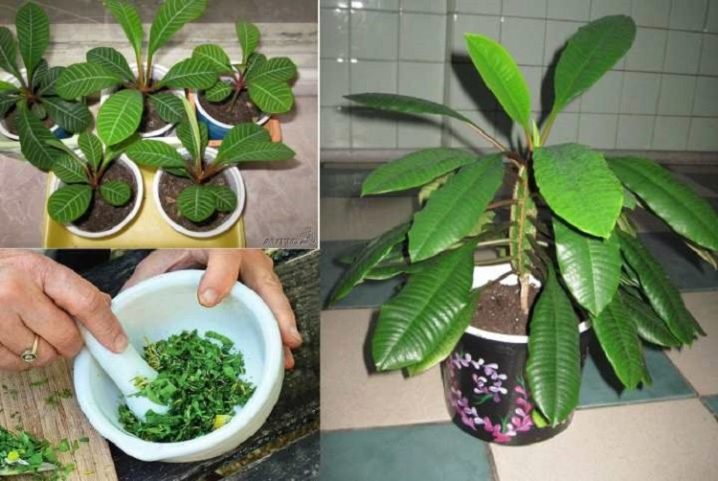
Landing
White-veined euphorbia has a superficial root system, like many other plants growing on sandy and rocky soils. For this reason, it is preferable to choose containers for such plants that are not very deep, but at the same time rather wide. Otherwise, water will stagnate at the bottom, which is not at all to the liking of this unusual green "pet".
As the plant grows up, the pot should be updated so that each subsequent one is 1-2 cm wider than the previous one.
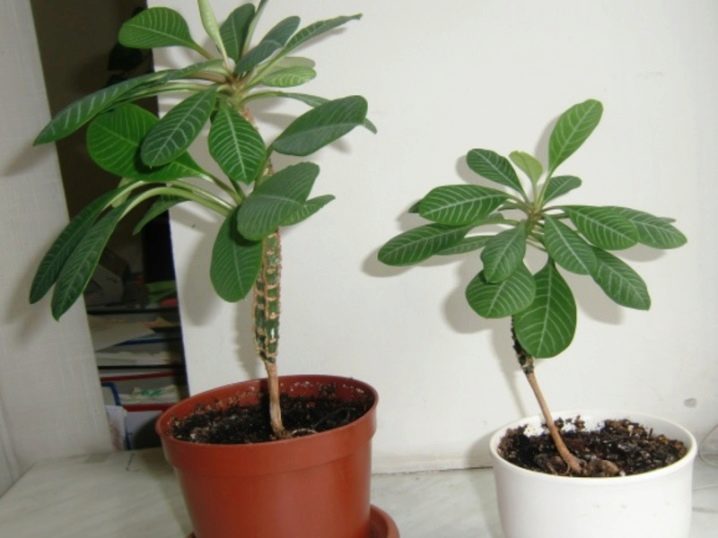
Landing containers can be made of almost any material. Glass, plastic, wood and ceramic containers are suitable for milkweed. But in this case, metal and enameled ones should not be used, since upon contact with water they begin to oxidize. Corrosion has the most detrimental effect on milkweed - most often it dies. Particular attention should be paid to drainage - at least 1/3 of the container must be filled with expanded clay or pebbles, and 4-5 holes must be provided at the bottom to remove excess moisture.
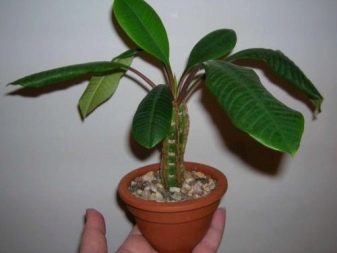
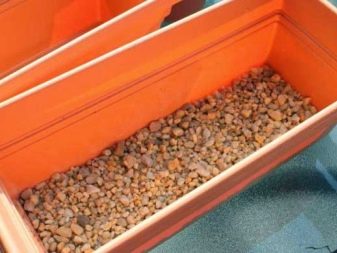
To create comfortable conditions for the growth and development of this succulent, you need to use a substrate made up of peat, as well as river sand, humus and the smallest pebbles, taken in equal proportions.
The plant can be fertilized immediately after planting. It is best to use potash top dressing, which must be applied to the ground immediately after watering. A young plant should be replanted every spring. As the milkweed grows older, one transplant can be carried out every 2-3 years. Since the plant is classified as a succulent, it can be transplanted at any time, regardless of the light and temperature conditions.
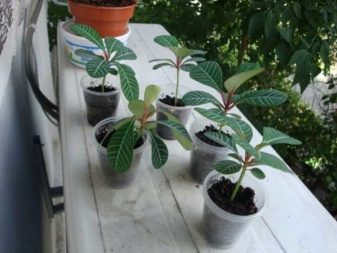

Care
Lighting
Euphorbia is a fairly large light-loving plant. It needs a long day of light (up to 12 hours). The light should be bright, but diffused, as scorching rays can burn the sheet plates. If a succulent plant is placed in a darkened place, then it gradually stops forming new leaves and increasing its green mass. If occasionally young leaves grow, they turn out to be very small and weak. If there is no other place for the plant, and you have planted euphorbia in partial shade, turn it from time to time so that the sun's rays touch all sides of the plant.
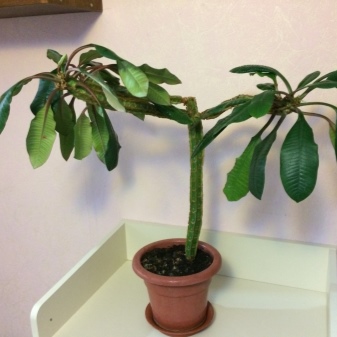
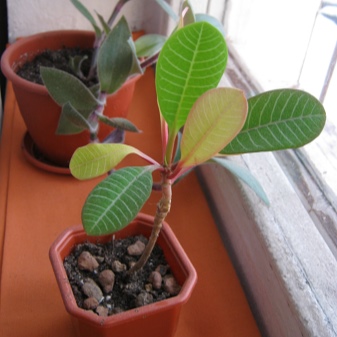
In the summertime, it will be useful to take the flower out into the garden and place it under the crown of the tree.
In winter, you need to additionally highlight the plant with special phytolamps. You can use ordinary fluorescent ones, but then give preference to models with a yellow glow spectrum and install the device at a distance of 50-55 cm from the plant.
Temperature
Like any other native of hot countries, Euphorbia loves warmth. The optimum temperature for a flower is 20-23 degrees. The critical maximum is 25 degrees. If the temperature is higher, then the leaves begin to turn yellow and fall off, and the achenes stop in their development. In winter, the plant also requires heat. It is advisable to provide him with a temperature background of 18 degrees. The minimum allowable level is 15 degrees. If the room is colder, the spurge will die very quickly.
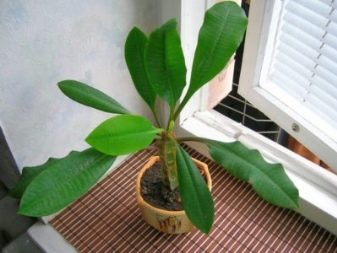
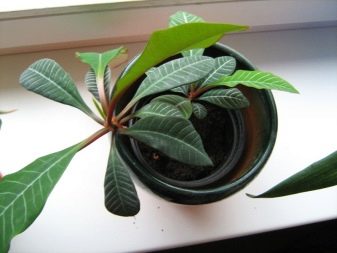
Humidity
Euphorbia loves humid climates, but the usual indoor microenvironment is also suitable for it. Moreover, the proximity of batteries and other heating devices does not harm him in any way, if, of course, they are at a short distance. Still, you should not put the plant close to the heating element. The supply of fresh air is very important for milkweed.
It is noticed that it noticeably comes to life after airing, but at the same time it does not tolerate drafts, therefore, when opening the window of the green "pet", you should take it away.


Watering
White-veined spurge should be watered frequently, but with a small amount of water. If you overdo it with watering even once, you can start the process of decay of the root system. On the other hand, the earthen coma should not be allowed to dry out, as this leads to shedding of the leaves. Keep in mind that in winter, the amount of watering should be drastically reduced - one irrigation per month is enough if the flower is located in a cool enough place. When keeping a plant in a heated room, watering should be carried out as the earthen coma dries out.
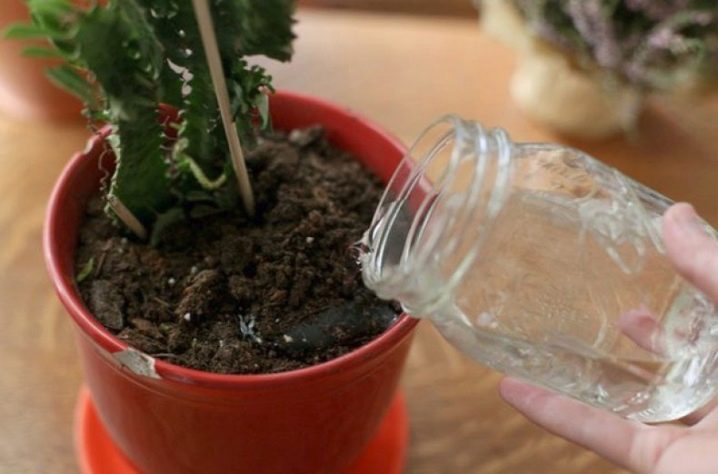
Top dressing
For feeding, you should choose ready-made mineral preparations for cacti and succulents. Top dressing is carried out from early March to October. Moreover, in the first spring month, it is advisable to dilute the composition 2-3 times more than indicated in the instructions for the preparation. Watering the flower in this way should be twice a month.
By the summer, the amount of dressings is reduced to 1 time in 3-4 weeks.
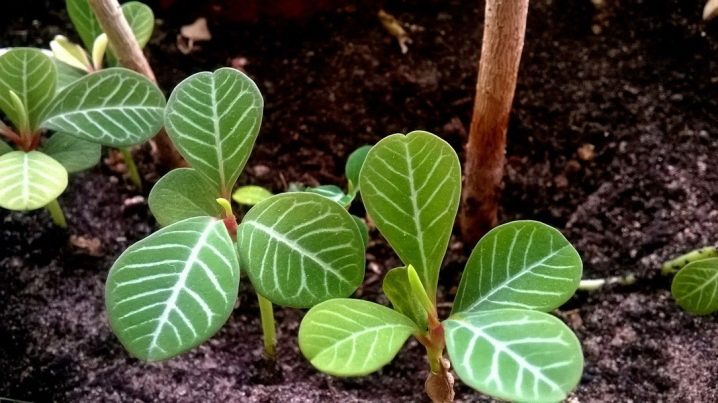
Pruning
Many gardeners are concerned about pruning milkweed. The fact is that it looks like an ornamental palm, so some inexperienced plant owners think that when pruned, they will destroy the exotic top. This is not true. Timely pruning contributes to the growth and formation of green mass. However, the procedure must be carried out correctly and accurately, using a scalpel or a very well-sharpened knife. The cut shoots can then be rooted (this will be discussed later).
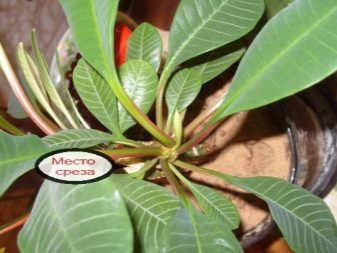

After cutting, it is necessary to process the cut site - hold it under running water at room temperature until it stops emitting milky juice, and then sprinkle with crushed activated carbon.
If you did everything correctly, then young leaves will appear soon, even if at the time of pruning they are completely gone.
Reproduction
By cuttings
Euphorbia is propagated vegetatively - by seeds or cuttings. Propagation by cuttings is one of the most common methods. This procedure is carried out in late spring - early summer. To do this, cut off shoots 4-6 cm long and immediately place them in a vessel with water (it must certainly be clean, soft and warm). After a couple of days, the release of juice stops. Then you can take out the cuttings and treat the cut with charcoal - this will help prevent the penetration of pathogenic microflora inside. Then you need to prepare the soil mixture, form a small depression, plant a stalk, sprinkle with earth and water a little. The soil must be tamped so that the cutting is placed in the center of the container. In the first 3 weeks, a young sprout should be disturbed as little as possible, since the plant is already under stress, so any deviation from the usual conditions only worsens the situation.
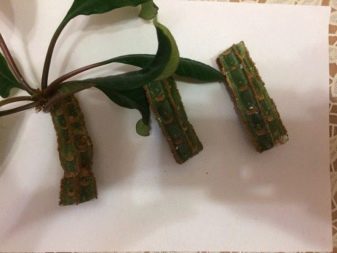
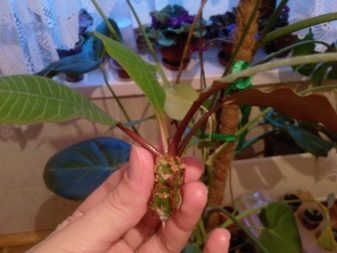
Seeds
Euphorbia can also be propagated by seeds. They can be purchased from the store or harvested from the mother plant. The seeds germinate quite quickly and in full. Subject to comfortable conditions, a full-fledged adult plant will grow in a year or two. Seeds are sown in loose soil, deepening by 5-6 mm, after which they are watered, placed in a cool place and left unattended for a couple of weeks. After the specified time has elapsed, the pot must be moved to a warmer environment and continued growing in conditions that are comfortable for milkweed. Usually, the first shoots can be seen in the third week after sowing, that is, after moving the container to heat, at least 7-8 days pass. Therefore, you should not worry about the fact that the stalks are not visible. When the seedlings reach 5 centimeters, you can transplant them to a permanent place.
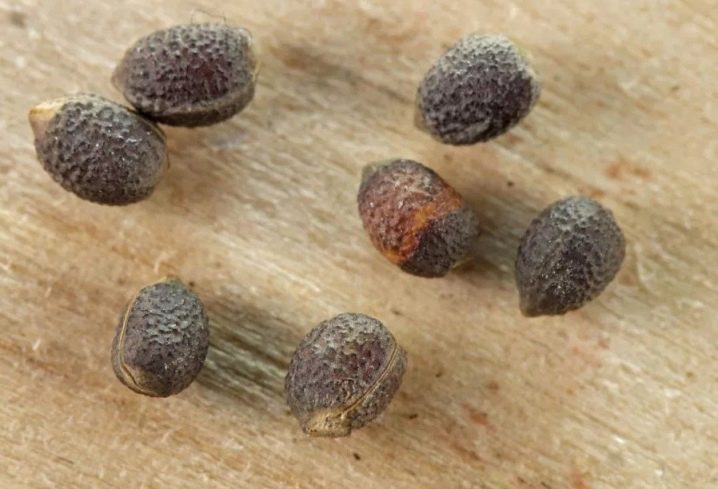
Diseases
Often novice growers do not understand why the flower has wilted, dropped its leaves or began to lose them.Let's figure out what should be done in such a situation. The most common cause of milkweed problems is fungal infections, which often result from waterlogged soil and low temperatures. You can fight them.
To do this, it is necessary to completely clean the roots of adhering soil, treat them with a weak solution of potassium permanganate and place in a new container.

As a result of excessive waterlogging, brown spots may appear on the leaves. In this case, the plant is treated with copper sulfate or Vectra and Alirinit-B preparations. Very often the roots are affected by late blight. It is difficult to notice and cure it - most often the affected plant dies. Despite the poisonous juice, euphorbia often becomes a victim of pests. Often on the succulent, you can see a thin cobweb with mites or scabbard plaques. They destroy insects with a solution of laundry soap. In more difficult cases, the plant is treated with an insecticide.
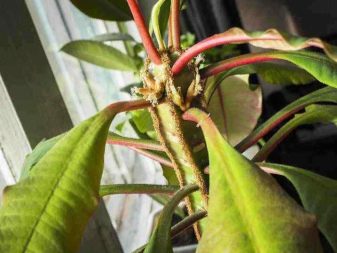
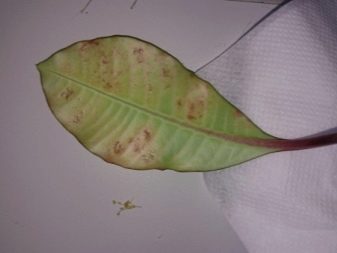
The average lifespan of the white-necked milkweed is 10 years. However, if you take good care of the green "pet", it will delight you with its unusual appearance for much longer.
For information on how to properly transplant the white-veined euphorbia, see the next video.























































The comment was sent successfully.